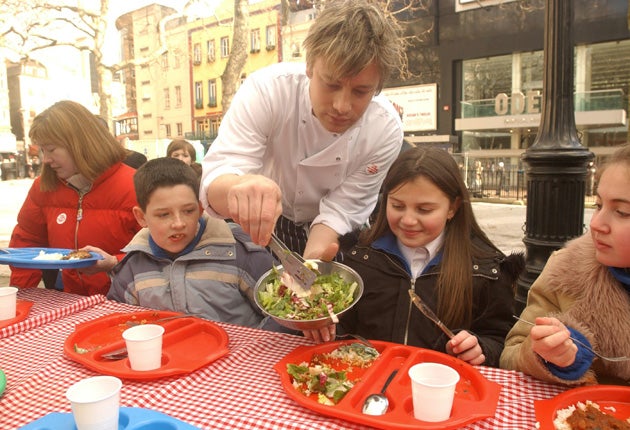Jamie's school dinners for all
New rules on healthy canteen menus inspired by TV chef come into force in secondary schools across the country

Your support helps us to tell the story
From reproductive rights to climate change to Big Tech, The Independent is on the ground when the story is developing. Whether it's investigating the financials of Elon Musk's pro-Trump PAC or producing our latest documentary, 'The A Word', which shines a light on the American women fighting for reproductive rights, we know how important it is to parse out the facts from the messaging.
At such a critical moment in US history, we need reporters on the ground. Your donation allows us to keep sending journalists to speak to both sides of the story.
The Independent is trusted by Americans across the entire political spectrum. And unlike many other quality news outlets, we choose not to lock Americans out of our reporting and analysis with paywalls. We believe quality journalism should be available to everyone, paid for by those who can afford it.
Your support makes all the difference.This week the revolution in school meals which was started by the TV chef Jamie Oliver's Channel 4 series will be complete.
From the beginning of September, secondary schools throughout the land will have to abide by new rules on what food they provide. Turkey Twizzlers are out, bring on the calypso chicken with pasta spirals.
It is a long way from Bradford in the 1880s, when free school meals were first given to the poor. Then, a meal meant porridge followed by bread and dripping. A "simple" dinner was served later in the day. The cost was limited to one old penny per pupil – in today's prices, 37p. The average cost of providing a dinner in 2009 is less than £5.
The main aim of the new standards is to give pupils healthy options. Deep-fried foods can only be served twice a week, sweet fizzy drinks are banned and at least one portion of fruit and one portion of vegetables must be served as part of lunch.
A sample menu from one school which has already implemented the changes is revealing. The main meals are chilli con carne served with fluffy brown rice (or, as a vegetarian alternative, fresh vegetable mornay bake with champ mashed potato). To follow there is apple cake with warm vanilla sauce or fresh fruit pieces.
Pizza is also on the menu, and theoretically pupils could eat it every day. It is not of the "greasy spoon" variety, though. The icing on the cake, so to speak, in the new standards is the setting of maximum levels of fat, salt and sugar and minimum levels of nutrients such as calcium and vitamins.
"We want to make sure children are eating a healthy, nutritious lunch at school because we know this helps their concentration in the classroom and their behaviour at home and at school," said the Schools minister, Diana Johnson.
The journey of the school meals service from 1880 to today has been a difficult one. After a faltering start, the Liberal government in 1906 passed legislation allowing all local authorities to serve free school meals. Provision was patchy. Even by the start of the Second World War, only half the country's local education authorities were offering them.
In the 1940s, it became national policy to deliver a nutritionally balanced school meal to all children which gave them 40 per cent of their daily protein and 33 per cent of their energy needs. This was enshrined in legislation in 1944. A typical menu would be steak and two veg followed by rhubarb crumble.
This largely remained in force until 1980, when Margaret Thatcher – known as the "milk snatcher" when she withdrew free milk from all children over seven in 1971 – decided to remove the rest of the food as well.
Her 1980 Education Act ended the obligation of local authorities to provide school meals. And meals no longer had to have a fixed price. Many secondary schools introduced cash cafeterias and the day of the Turkey Twizzler dawned. For those entitled to free school meals in areas which abolished the service, a packed lunch was introduced.
Only after Jamie Oliver's intervention did ministers become serious about standards. On the day the television chef delivered a petition to the then prime minister, Tony Blair announced a £280m revamp for the service.
Initially, the drive for healthier eating proved disastrous, with a 5 per cent drop in take-up in the first year. The drop has now levelled off, though.
Will it work? The proof of the pudding will – as they say – be in the eating.
What's for lunch? Menus through the years
*1880 The first few schools provide meals for the very poorest children. Breakfast and dinner were served at school – breakfast consisting of porridge with milk and treacle, followed by bread with margarine or dripping, with milk, hot or cold, to drink. Dinner consisted of a "simple" meal of two courses – probably gruel followed by an apple.
*1944 Legislation to make it compulsory for all schools to provide dinners with agreed nutritional content. Meals had to be large enough for main meal of the day. Typical menu would be steak and kidney pie and two veg followed by rhubarb crumble.
*1980 Conservatives abolished nutritional standards and removed obligation to provide meals. Cash cafeteria system introduced with Turkey Twizzlers and burgers and chips.
*2009 New food and nutrient standards become compulsory in all schools meaning deep fried foods only served twice a week and sweet fizzy drinks are banned.
Join our commenting forum
Join thought-provoking conversations, follow other Independent readers and see their replies
Comments